Taxation Law Case Study: RIP Pty Ltd
VerifiedAdded on 2023/06/11
|12
|3467
|261
AI Summary
This case study discusses the tax treatment of various transactions of RIP Pty Ltd, a funeral director company in Australia. It covers the tax treatment of Easy Funeral Plan, Forfeited Payments Account, trading stock, fully franked dividends, rental space, long service leave, and construction expenditure. The case study uses relevant sections of the Income Tax Assessment Act 1936 and 1997 to provide advice on the tax treatment of each transaction.
Contribute Materials
Your contribution can guide someone’s learning journey. Share your
documents today.
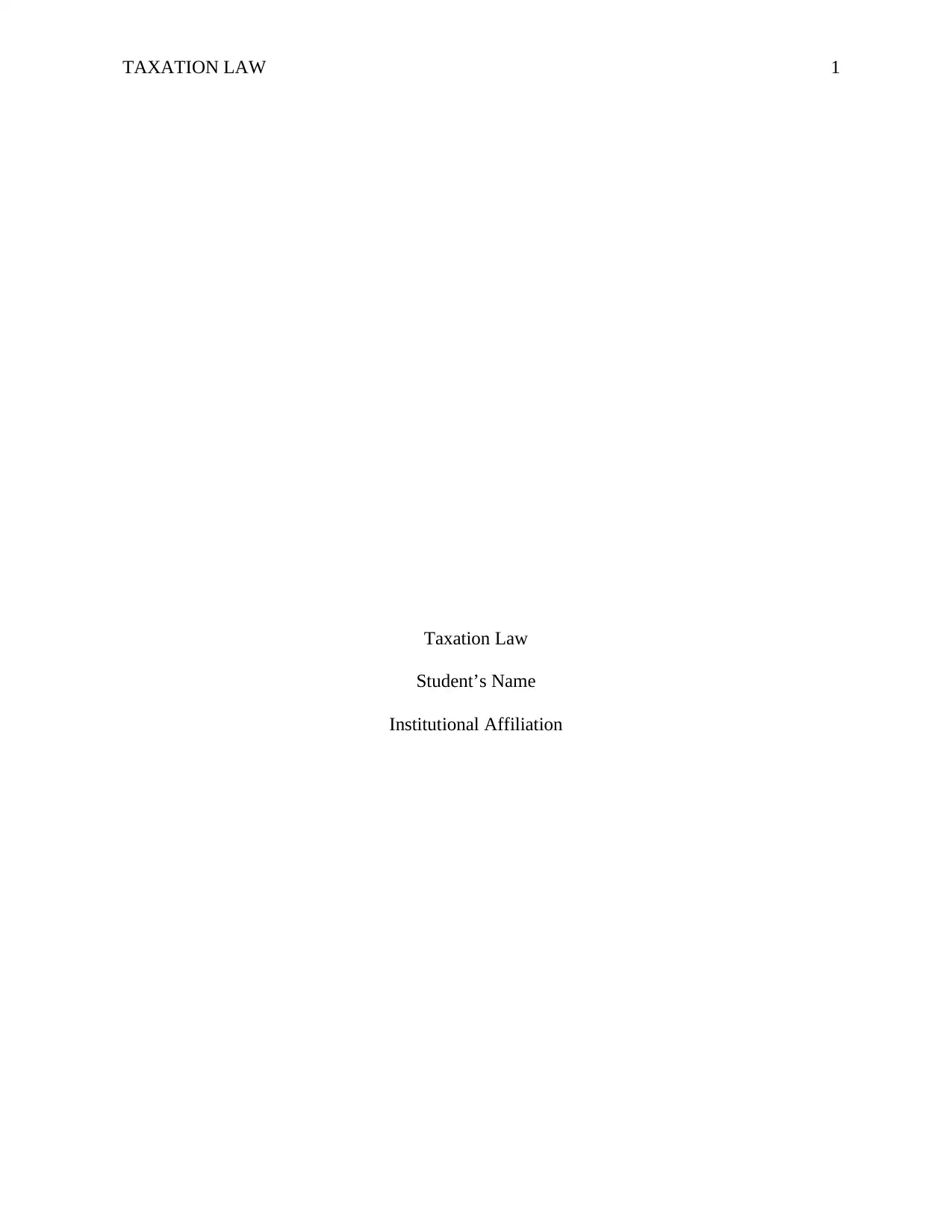
TAXATION LAW 1
Taxation Law
Student’s Name
Institutional Affiliation
Taxation Law
Student’s Name
Institutional Affiliation
Secure Best Marks with AI Grader
Need help grading? Try our AI Grader for instant feedback on your assignments.
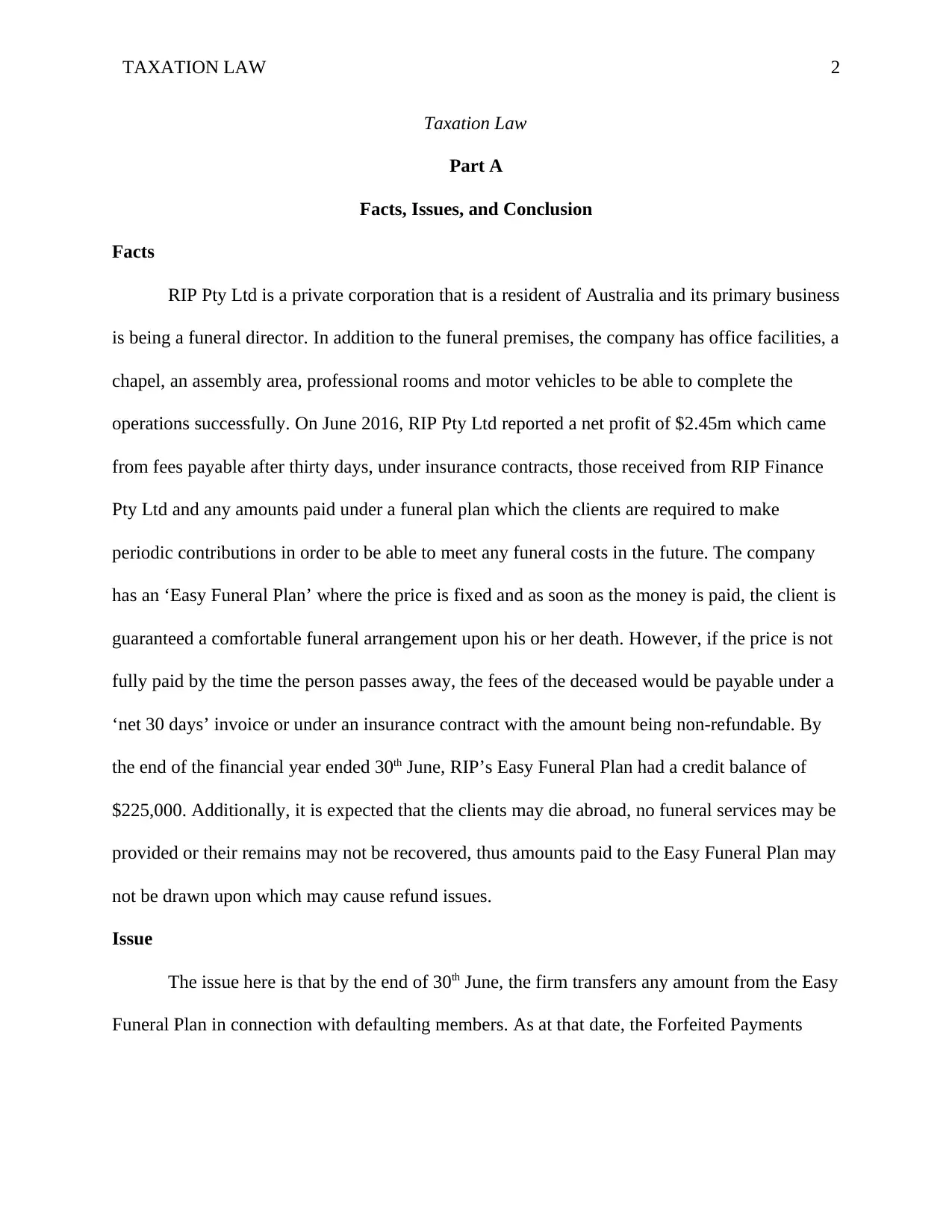
TAXATION LAW 2
Taxation Law
Part A
Facts, Issues, and Conclusion
Facts
RIP Pty Ltd is a private corporation that is a resident of Australia and its primary business
is being a funeral director. In addition to the funeral premises, the company has office facilities, a
chapel, an assembly area, professional rooms and motor vehicles to be able to complete the
operations successfully. On June 2016, RIP Pty Ltd reported a net profit of $2.45m which came
from fees payable after thirty days, under insurance contracts, those received from RIP Finance
Pty Ltd and any amounts paid under a funeral plan which the clients are required to make
periodic contributions in order to be able to meet any funeral costs in the future. The company
has an ‘Easy Funeral Plan’ where the price is fixed and as soon as the money is paid, the client is
guaranteed a comfortable funeral arrangement upon his or her death. However, if the price is not
fully paid by the time the person passes away, the fees of the deceased would be payable under a
‘net 30 days’ invoice or under an insurance contract with the amount being non-refundable. By
the end of the financial year ended 30th June, RIP’s Easy Funeral Plan had a credit balance of
$225,000. Additionally, it is expected that the clients may die abroad, no funeral services may be
provided or their remains may not be recovered, thus amounts paid to the Easy Funeral Plan may
not be drawn upon which may cause refund issues.
Issue
The issue here is that by the end of 30th June, the firm transfers any amount from the Easy
Funeral Plan in connection with defaulting members. As at that date, the Forfeited Payments
Taxation Law
Part A
Facts, Issues, and Conclusion
Facts
RIP Pty Ltd is a private corporation that is a resident of Australia and its primary business
is being a funeral director. In addition to the funeral premises, the company has office facilities, a
chapel, an assembly area, professional rooms and motor vehicles to be able to complete the
operations successfully. On June 2016, RIP Pty Ltd reported a net profit of $2.45m which came
from fees payable after thirty days, under insurance contracts, those received from RIP Finance
Pty Ltd and any amounts paid under a funeral plan which the clients are required to make
periodic contributions in order to be able to meet any funeral costs in the future. The company
has an ‘Easy Funeral Plan’ where the price is fixed and as soon as the money is paid, the client is
guaranteed a comfortable funeral arrangement upon his or her death. However, if the price is not
fully paid by the time the person passes away, the fees of the deceased would be payable under a
‘net 30 days’ invoice or under an insurance contract with the amount being non-refundable. By
the end of the financial year ended 30th June, RIP’s Easy Funeral Plan had a credit balance of
$225,000. Additionally, it is expected that the clients may die abroad, no funeral services may be
provided or their remains may not be recovered, thus amounts paid to the Easy Funeral Plan may
not be drawn upon which may cause refund issues.
Issue
The issue here is that by the end of 30th June, the firm transfers any amount from the Easy
Funeral Plan in connection with defaulting members. As at that date, the Forfeited Payments
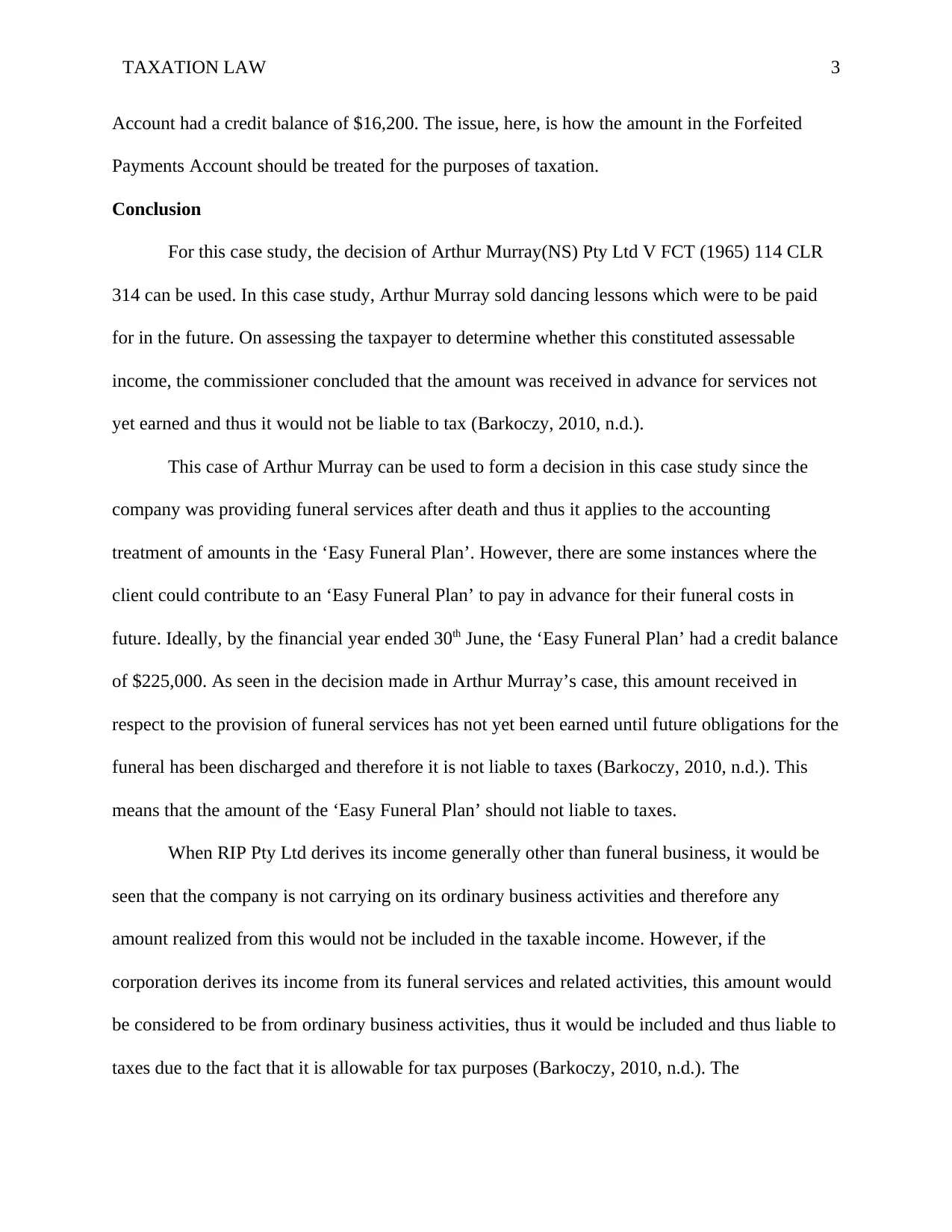
TAXATION LAW 3
Account had a credit balance of $16,200. The issue, here, is how the amount in the Forfeited
Payments Account should be treated for the purposes of taxation.
Conclusion
For this case study, the decision of Arthur Murray(NS) Pty Ltd V FCT (1965) 114 CLR
314 can be used. In this case study, Arthur Murray sold dancing lessons which were to be paid
for in the future. On assessing the taxpayer to determine whether this constituted assessable
income, the commissioner concluded that the amount was received in advance for services not
yet earned and thus it would not be liable to tax (Barkoczy, 2010, n.d.).
This case of Arthur Murray can be used to form a decision in this case study since the
company was providing funeral services after death and thus it applies to the accounting
treatment of amounts in the ‘Easy Funeral Plan’. However, there are some instances where the
client could contribute to an ‘Easy Funeral Plan’ to pay in advance for their funeral costs in
future. Ideally, by the financial year ended 30th June, the ‘Easy Funeral Plan’ had a credit balance
of $225,000. As seen in the decision made in Arthur Murray’s case, this amount received in
respect to the provision of funeral services has not yet been earned until future obligations for the
funeral has been discharged and therefore it is not liable to taxes (Barkoczy, 2010, n.d.). This
means that the amount of the ‘Easy Funeral Plan’ should not liable to taxes.
When RIP Pty Ltd derives its income generally other than funeral business, it would be
seen that the company is not carrying on its ordinary business activities and therefore any
amount realized from this would not be included in the taxable income. However, if the
corporation derives its income from its funeral services and related activities, this amount would
be considered to be from ordinary business activities, thus it would be included and thus liable to
taxes due to the fact that it is allowable for tax purposes (Barkoczy, 2010, n.d.). The
Account had a credit balance of $16,200. The issue, here, is how the amount in the Forfeited
Payments Account should be treated for the purposes of taxation.
Conclusion
For this case study, the decision of Arthur Murray(NS) Pty Ltd V FCT (1965) 114 CLR
314 can be used. In this case study, Arthur Murray sold dancing lessons which were to be paid
for in the future. On assessing the taxpayer to determine whether this constituted assessable
income, the commissioner concluded that the amount was received in advance for services not
yet earned and thus it would not be liable to tax (Barkoczy, 2010, n.d.).
This case of Arthur Murray can be used to form a decision in this case study since the
company was providing funeral services after death and thus it applies to the accounting
treatment of amounts in the ‘Easy Funeral Plan’. However, there are some instances where the
client could contribute to an ‘Easy Funeral Plan’ to pay in advance for their funeral costs in
future. Ideally, by the financial year ended 30th June, the ‘Easy Funeral Plan’ had a credit balance
of $225,000. As seen in the decision made in Arthur Murray’s case, this amount received in
respect to the provision of funeral services has not yet been earned until future obligations for the
funeral has been discharged and therefore it is not liable to taxes (Barkoczy, 2010, n.d.). This
means that the amount of the ‘Easy Funeral Plan’ should not liable to taxes.
When RIP Pty Ltd derives its income generally other than funeral business, it would be
seen that the company is not carrying on its ordinary business activities and therefore any
amount realized from this would not be included in the taxable income. However, if the
corporation derives its income from its funeral services and related activities, this amount would
be considered to be from ordinary business activities, thus it would be included and thus liable to
taxes due to the fact that it is allowable for tax purposes (Barkoczy, 2010, n.d.). The

TAXATION LAW 4
commissioner or any taxpayer does not have a choice in the method of accounting for tax since
the respective law must be followed when preparing the statement of taxable income of RIP Pty
Ltd. Another scenario may occur when the client dies abroad. In such a scenario, the amount in
the ‘Easy Funeral Plan’ of $225,000 should be included in the assessable income since it is
evident that the obligations for the funeral arrangements will be discharged (Barkoczy, 2010,
n.d.).
Advice on the Tax Treatment of $16,200 in the ‘Forfeitures Payments Account’
According to section 104-150 of the ITAA 1997, when a deposit is forfeited and a
taxpayer makes a capital gain, the capital gain would be the deposit less the deposit less any
expenses in relation to the sale. However, when the taxpayer makes a capital loss, the capital loss
would be computed as the expenditure in relation to the sale less the deposit forfeited. According
to taxation ruling 97/19 Para 7, a CGT provision applies to the effect that a forfeited deposit may
be considered as a capital gain in certain circumstances. In this case study, RIP Pty Ltd had
$16,200 in the ‘Forfeitures Payments Account’. This amount of $16200 that was paid by
defaulting members would be considered as a capital gain and thus it should be included in the
assessable income under sec 104 -150 of ITAA 1997and TR 97/19. Therefore, the capital gain
attributable to RIP Pty Ltd would be computed as the deposit by the members who defaulted
payment less any expenditure associated with the sale, that is, the funeral services. However,
since RIP Pty Ltd is not incurring any expenses for this amount, the capital gain would just be
the deposit by the defaulted members, that is, $16,200.
Part B
Part a
commissioner or any taxpayer does not have a choice in the method of accounting for tax since
the respective law must be followed when preparing the statement of taxable income of RIP Pty
Ltd. Another scenario may occur when the client dies abroad. In such a scenario, the amount in
the ‘Easy Funeral Plan’ of $225,000 should be included in the assessable income since it is
evident that the obligations for the funeral arrangements will be discharged (Barkoczy, 2010,
n.d.).
Advice on the Tax Treatment of $16,200 in the ‘Forfeitures Payments Account’
According to section 104-150 of the ITAA 1997, when a deposit is forfeited and a
taxpayer makes a capital gain, the capital gain would be the deposit less the deposit less any
expenses in relation to the sale. However, when the taxpayer makes a capital loss, the capital loss
would be computed as the expenditure in relation to the sale less the deposit forfeited. According
to taxation ruling 97/19 Para 7, a CGT provision applies to the effect that a forfeited deposit may
be considered as a capital gain in certain circumstances. In this case study, RIP Pty Ltd had
$16,200 in the ‘Forfeitures Payments Account’. This amount of $16200 that was paid by
defaulting members would be considered as a capital gain and thus it should be included in the
assessable income under sec 104 -150 of ITAA 1997and TR 97/19. Therefore, the capital gain
attributable to RIP Pty Ltd would be computed as the deposit by the members who defaulted
payment less any expenditure associated with the sale, that is, the funeral services. However,
since RIP Pty Ltd is not incurring any expenses for this amount, the capital gain would just be
the deposit by the defaulted members, that is, $16,200.
Part B
Part a
Secure Best Marks with AI Grader
Need help grading? Try our AI Grader for instant feedback on your assignments.
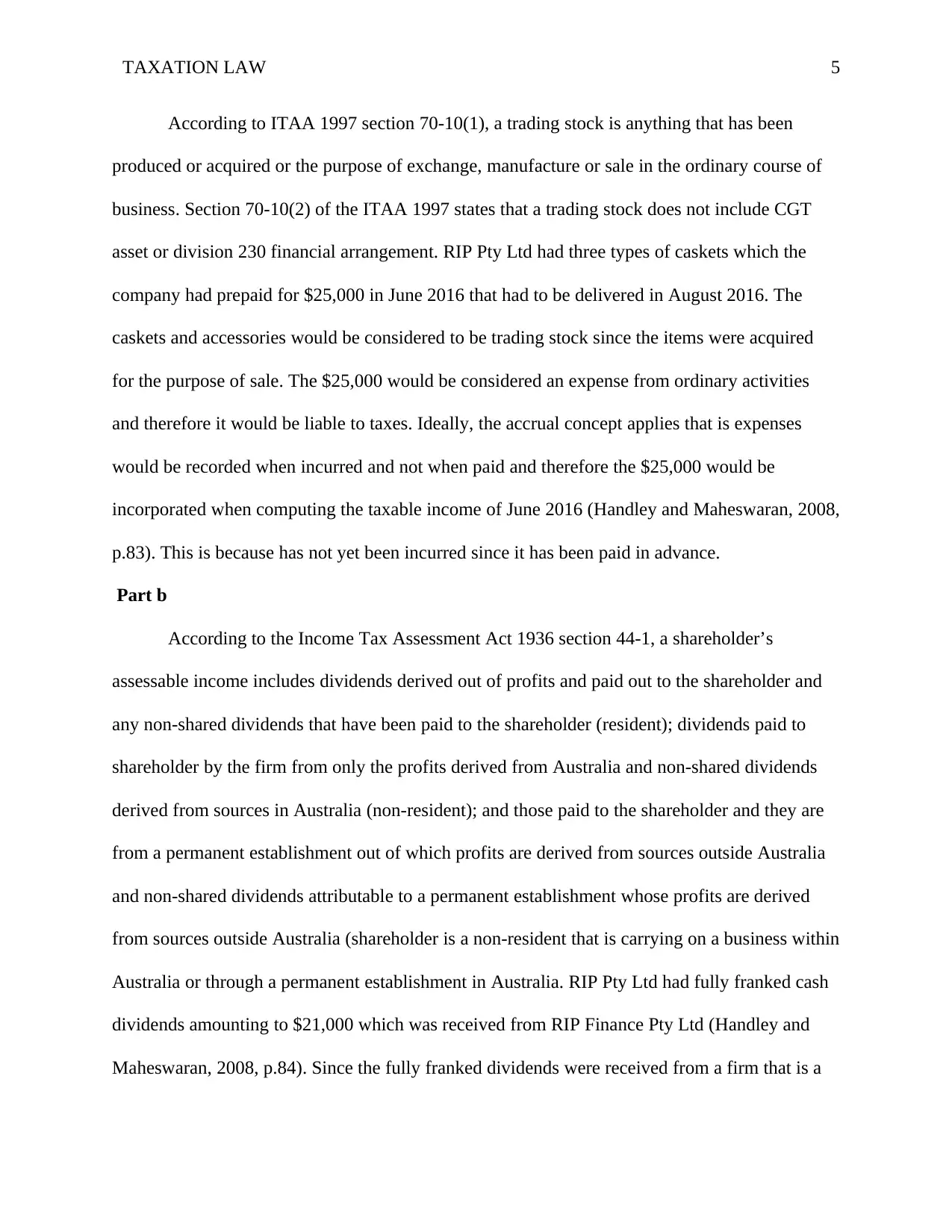
TAXATION LAW 5
According to ITAA 1997 section 70-10(1), a trading stock is anything that has been
produced or acquired or the purpose of exchange, manufacture or sale in the ordinary course of
business. Section 70-10(2) of the ITAA 1997 states that a trading stock does not include CGT
asset or division 230 financial arrangement. RIP Pty Ltd had three types of caskets which the
company had prepaid for $25,000 in June 2016 that had to be delivered in August 2016. The
caskets and accessories would be considered to be trading stock since the items were acquired
for the purpose of sale. The $25,000 would be considered an expense from ordinary activities
and therefore it would be liable to taxes. Ideally, the accrual concept applies that is expenses
would be recorded when incurred and not when paid and therefore the $25,000 would be
incorporated when computing the taxable income of June 2016 (Handley and Maheswaran, 2008,
p.83). This is because has not yet been incurred since it has been paid in advance.
Part b
According to the Income Tax Assessment Act 1936 section 44-1, a shareholder’s
assessable income includes dividends derived out of profits and paid out to the shareholder and
any non-shared dividends that have been paid to the shareholder (resident); dividends paid to
shareholder by the firm from only the profits derived from Australia and non-shared dividends
derived from sources in Australia (non-resident); and those paid to the shareholder and they are
from a permanent establishment out of which profits are derived from sources outside Australia
and non-shared dividends attributable to a permanent establishment whose profits are derived
from sources outside Australia (shareholder is a non-resident that is carrying on a business within
Australia or through a permanent establishment in Australia. RIP Pty Ltd had fully franked cash
dividends amounting to $21,000 which was received from RIP Finance Pty Ltd (Handley and
Maheswaran, 2008, p.84). Since the fully franked dividends were received from a firm that is a
According to ITAA 1997 section 70-10(1), a trading stock is anything that has been
produced or acquired or the purpose of exchange, manufacture or sale in the ordinary course of
business. Section 70-10(2) of the ITAA 1997 states that a trading stock does not include CGT
asset or division 230 financial arrangement. RIP Pty Ltd had three types of caskets which the
company had prepaid for $25,000 in June 2016 that had to be delivered in August 2016. The
caskets and accessories would be considered to be trading stock since the items were acquired
for the purpose of sale. The $25,000 would be considered an expense from ordinary activities
and therefore it would be liable to taxes. Ideally, the accrual concept applies that is expenses
would be recorded when incurred and not when paid and therefore the $25,000 would be
incorporated when computing the taxable income of June 2016 (Handley and Maheswaran, 2008,
p.83). This is because has not yet been incurred since it has been paid in advance.
Part b
According to the Income Tax Assessment Act 1936 section 44-1, a shareholder’s
assessable income includes dividends derived out of profits and paid out to the shareholder and
any non-shared dividends that have been paid to the shareholder (resident); dividends paid to
shareholder by the firm from only the profits derived from Australia and non-shared dividends
derived from sources in Australia (non-resident); and those paid to the shareholder and they are
from a permanent establishment out of which profits are derived from sources outside Australia
and non-shared dividends attributable to a permanent establishment whose profits are derived
from sources outside Australia (shareholder is a non-resident that is carrying on a business within
Australia or through a permanent establishment in Australia. RIP Pty Ltd had fully franked cash
dividends amounting to $21,000 which was received from RIP Finance Pty Ltd (Handley and
Maheswaran, 2008, p.84). Since the fully franked dividends were received from a firm that is a
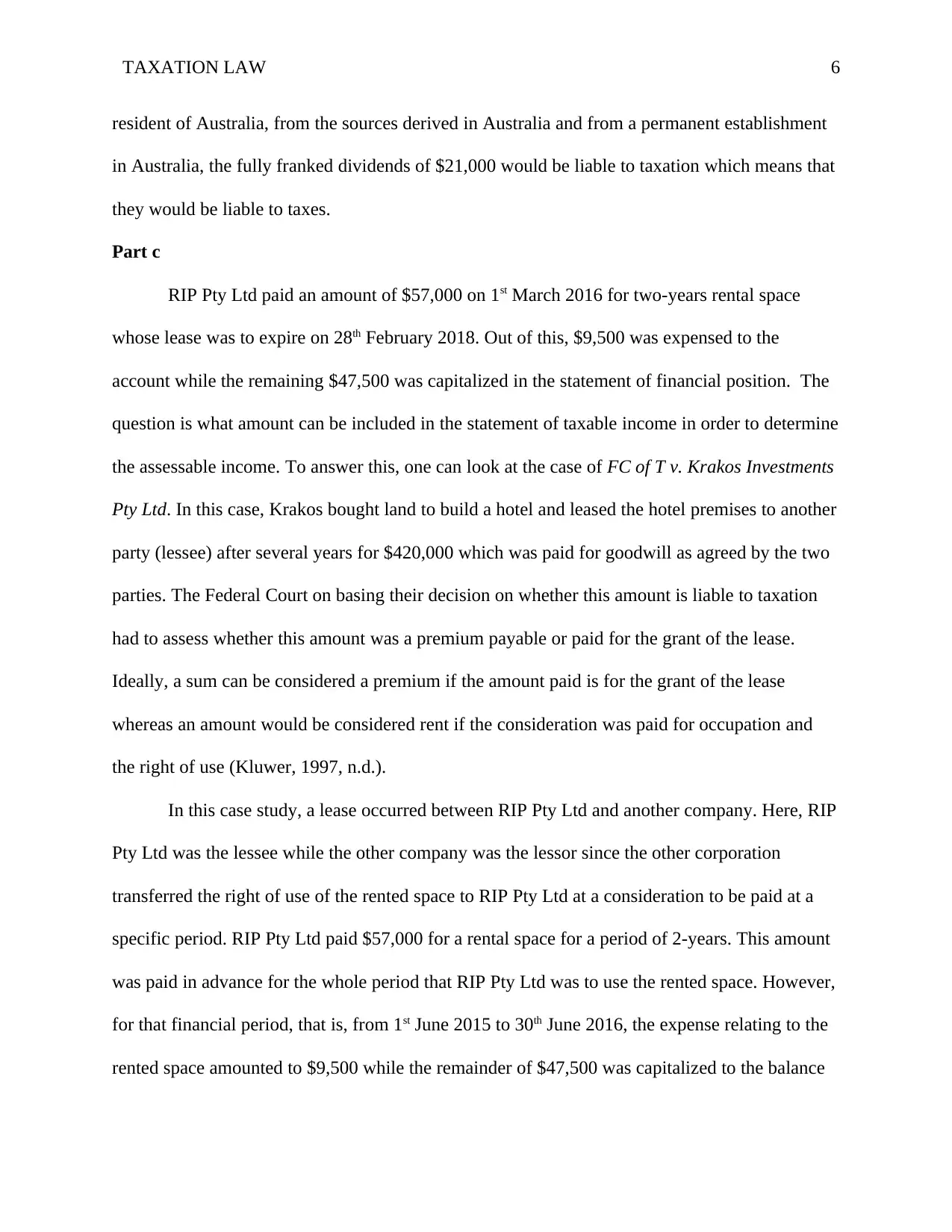
TAXATION LAW 6
resident of Australia, from the sources derived in Australia and from a permanent establishment
in Australia, the fully franked dividends of $21,000 would be liable to taxation which means that
they would be liable to taxes.
Part c
RIP Pty Ltd paid an amount of $57,000 on 1st March 2016 for two-years rental space
whose lease was to expire on 28th February 2018. Out of this, $9,500 was expensed to the
account while the remaining $47,500 was capitalized in the statement of financial position. The
question is what amount can be included in the statement of taxable income in order to determine
the assessable income. To answer this, one can look at the case of FC of T v. Krakos Investments
Pty Ltd. In this case, Krakos bought land to build a hotel and leased the hotel premises to another
party (lessee) after several years for $420,000 which was paid for goodwill as agreed by the two
parties. The Federal Court on basing their decision on whether this amount is liable to taxation
had to assess whether this amount was a premium payable or paid for the grant of the lease.
Ideally, a sum can be considered a premium if the amount paid is for the grant of the lease
whereas an amount would be considered rent if the consideration was paid for occupation and
the right of use (Kluwer, 1997, n.d.).
In this case study, a lease occurred between RIP Pty Ltd and another company. Here, RIP
Pty Ltd was the lessee while the other company was the lessor since the other corporation
transferred the right of use of the rented space to RIP Pty Ltd at a consideration to be paid at a
specific period. RIP Pty Ltd paid $57,000 for a rental space for a period of 2-years. This amount
was paid in advance for the whole period that RIP Pty Ltd was to use the rented space. However,
for that financial period, that is, from 1st June 2015 to 30th June 2016, the expense relating to the
rented space amounted to $9,500 while the remainder of $47,500 was capitalized to the balance
resident of Australia, from the sources derived in Australia and from a permanent establishment
in Australia, the fully franked dividends of $21,000 would be liable to taxation which means that
they would be liable to taxes.
Part c
RIP Pty Ltd paid an amount of $57,000 on 1st March 2016 for two-years rental space
whose lease was to expire on 28th February 2018. Out of this, $9,500 was expensed to the
account while the remaining $47,500 was capitalized in the statement of financial position. The
question is what amount can be included in the statement of taxable income in order to determine
the assessable income. To answer this, one can look at the case of FC of T v. Krakos Investments
Pty Ltd. In this case, Krakos bought land to build a hotel and leased the hotel premises to another
party (lessee) after several years for $420,000 which was paid for goodwill as agreed by the two
parties. The Federal Court on basing their decision on whether this amount is liable to taxation
had to assess whether this amount was a premium payable or paid for the grant of the lease.
Ideally, a sum can be considered a premium if the amount paid is for the grant of the lease
whereas an amount would be considered rent if the consideration was paid for occupation and
the right of use (Kluwer, 1997, n.d.).
In this case study, a lease occurred between RIP Pty Ltd and another company. Here, RIP
Pty Ltd was the lessee while the other company was the lessor since the other corporation
transferred the right of use of the rented space to RIP Pty Ltd at a consideration to be paid at a
specific period. RIP Pty Ltd paid $57,000 for a rental space for a period of 2-years. This amount
was paid in advance for the whole period that RIP Pty Ltd was to use the rented space. However,
for that financial period, that is, from 1st June 2015 to 30th June 2016, the expense relating to the
rented space amounted to $9,500 while the remainder of $47,500 was capitalized to the balance
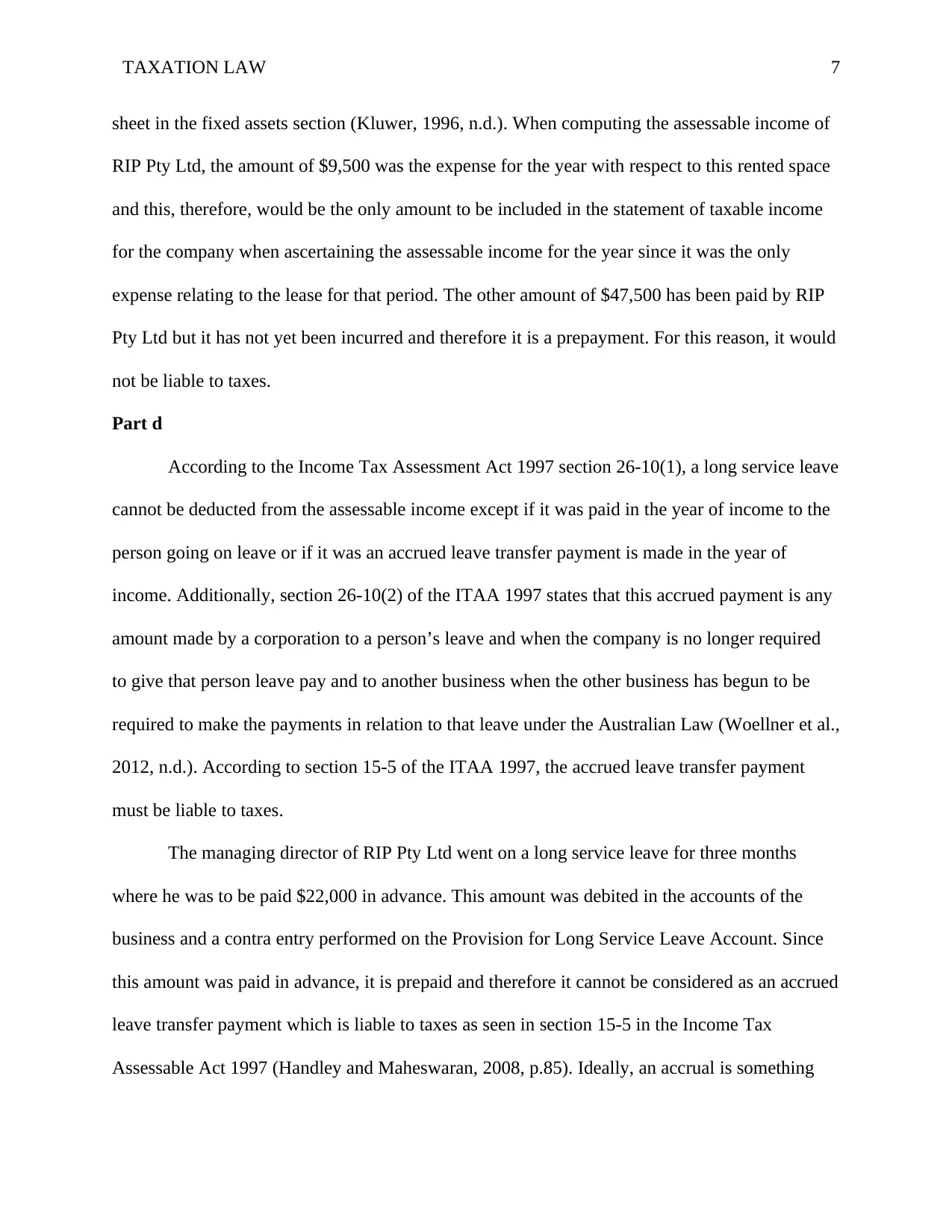
TAXATION LAW 7
sheet in the fixed assets section (Kluwer, 1996, n.d.). When computing the assessable income of
RIP Pty Ltd, the amount of $9,500 was the expense for the year with respect to this rented space
and this, therefore, would be the only amount to be included in the statement of taxable income
for the company when ascertaining the assessable income for the year since it was the only
expense relating to the lease for that period. The other amount of $47,500 has been paid by RIP
Pty Ltd but it has not yet been incurred and therefore it is a prepayment. For this reason, it would
not be liable to taxes.
Part d
According to the Income Tax Assessment Act 1997 section 26-10(1), a long service leave
cannot be deducted from the assessable income except if it was paid in the year of income to the
person going on leave or if it was an accrued leave transfer payment is made in the year of
income. Additionally, section 26-10(2) of the ITAA 1997 states that this accrued payment is any
amount made by a corporation to a person’s leave and when the company is no longer required
to give that person leave pay and to another business when the other business has begun to be
required to make the payments in relation to that leave under the Australian Law (Woellner et al.,
2012, n.d.). According to section 15-5 of the ITAA 1997, the accrued leave transfer payment
must be liable to taxes.
The managing director of RIP Pty Ltd went on a long service leave for three months
where he was to be paid $22,000 in advance. This amount was debited in the accounts of the
business and a contra entry performed on the Provision for Long Service Leave Account. Since
this amount was paid in advance, it is prepaid and therefore it cannot be considered as an accrued
leave transfer payment which is liable to taxes as seen in section 15-5 in the Income Tax
Assessable Act 1997 (Handley and Maheswaran, 2008, p.85). Ideally, an accrual is something
sheet in the fixed assets section (Kluwer, 1996, n.d.). When computing the assessable income of
RIP Pty Ltd, the amount of $9,500 was the expense for the year with respect to this rented space
and this, therefore, would be the only amount to be included in the statement of taxable income
for the company when ascertaining the assessable income for the year since it was the only
expense relating to the lease for that period. The other amount of $47,500 has been paid by RIP
Pty Ltd but it has not yet been incurred and therefore it is a prepayment. For this reason, it would
not be liable to taxes.
Part d
According to the Income Tax Assessment Act 1997 section 26-10(1), a long service leave
cannot be deducted from the assessable income except if it was paid in the year of income to the
person going on leave or if it was an accrued leave transfer payment is made in the year of
income. Additionally, section 26-10(2) of the ITAA 1997 states that this accrued payment is any
amount made by a corporation to a person’s leave and when the company is no longer required
to give that person leave pay and to another business when the other business has begun to be
required to make the payments in relation to that leave under the Australian Law (Woellner et al.,
2012, n.d.). According to section 15-5 of the ITAA 1997, the accrued leave transfer payment
must be liable to taxes.
The managing director of RIP Pty Ltd went on a long service leave for three months
where he was to be paid $22,000 in advance. This amount was debited in the accounts of the
business and a contra entry performed on the Provision for Long Service Leave Account. Since
this amount was paid in advance, it is prepaid and therefore it cannot be considered as an accrued
leave transfer payment which is liable to taxes as seen in section 15-5 in the Income Tax
Assessable Act 1997 (Handley and Maheswaran, 2008, p.85). Ideally, an accrual is something
Paraphrase This Document
Need a fresh take? Get an instant paraphrase of this document with our AI Paraphraser
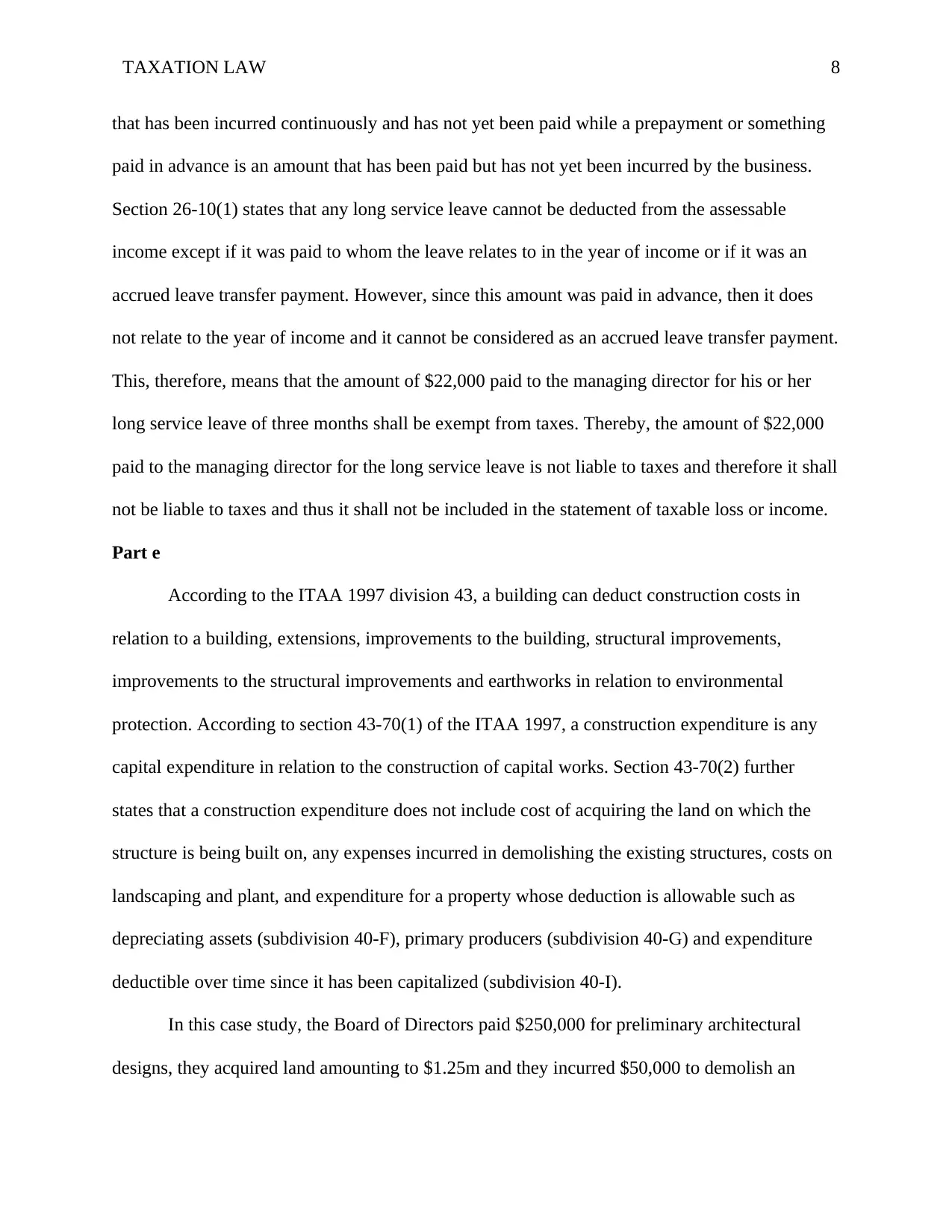
TAXATION LAW 8
that has been incurred continuously and has not yet been paid while a prepayment or something
paid in advance is an amount that has been paid but has not yet been incurred by the business.
Section 26-10(1) states that any long service leave cannot be deducted from the assessable
income except if it was paid to whom the leave relates to in the year of income or if it was an
accrued leave transfer payment. However, since this amount was paid in advance, then it does
not relate to the year of income and it cannot be considered as an accrued leave transfer payment.
This, therefore, means that the amount of $22,000 paid to the managing director for his or her
long service leave of three months shall be exempt from taxes. Thereby, the amount of $22,000
paid to the managing director for the long service leave is not liable to taxes and therefore it shall
not be liable to taxes and thus it shall not be included in the statement of taxable loss or income.
Part e
According to the ITAA 1997 division 43, a building can deduct construction costs in
relation to a building, extensions, improvements to the building, structural improvements,
improvements to the structural improvements and earthworks in relation to environmental
protection. According to section 43-70(1) of the ITAA 1997, a construction expenditure is any
capital expenditure in relation to the construction of capital works. Section 43-70(2) further
states that a construction expenditure does not include cost of acquiring the land on which the
structure is being built on, any expenses incurred in demolishing the existing structures, costs on
landscaping and plant, and expenditure for a property whose deduction is allowable such as
depreciating assets (subdivision 40-F), primary producers (subdivision 40-G) and expenditure
deductible over time since it has been capitalized (subdivision 40-I).
In this case study, the Board of Directors paid $250,000 for preliminary architectural
designs, they acquired land amounting to $1.25m and they incurred $50,000 to demolish an
that has been incurred continuously and has not yet been paid while a prepayment or something
paid in advance is an amount that has been paid but has not yet been incurred by the business.
Section 26-10(1) states that any long service leave cannot be deducted from the assessable
income except if it was paid to whom the leave relates to in the year of income or if it was an
accrued leave transfer payment. However, since this amount was paid in advance, then it does
not relate to the year of income and it cannot be considered as an accrued leave transfer payment.
This, therefore, means that the amount of $22,000 paid to the managing director for his or her
long service leave of three months shall be exempt from taxes. Thereby, the amount of $22,000
paid to the managing director for the long service leave is not liable to taxes and therefore it shall
not be liable to taxes and thus it shall not be included in the statement of taxable loss or income.
Part e
According to the ITAA 1997 division 43, a building can deduct construction costs in
relation to a building, extensions, improvements to the building, structural improvements,
improvements to the structural improvements and earthworks in relation to environmental
protection. According to section 43-70(1) of the ITAA 1997, a construction expenditure is any
capital expenditure in relation to the construction of capital works. Section 43-70(2) further
states that a construction expenditure does not include cost of acquiring the land on which the
structure is being built on, any expenses incurred in demolishing the existing structures, costs on
landscaping and plant, and expenditure for a property whose deduction is allowable such as
depreciating assets (subdivision 40-F), primary producers (subdivision 40-G) and expenditure
deductible over time since it has been capitalized (subdivision 40-I).
In this case study, the Board of Directors paid $250,000 for preliminary architectural
designs, they acquired land amounting to $1.25m and they incurred $50,000 to demolish an
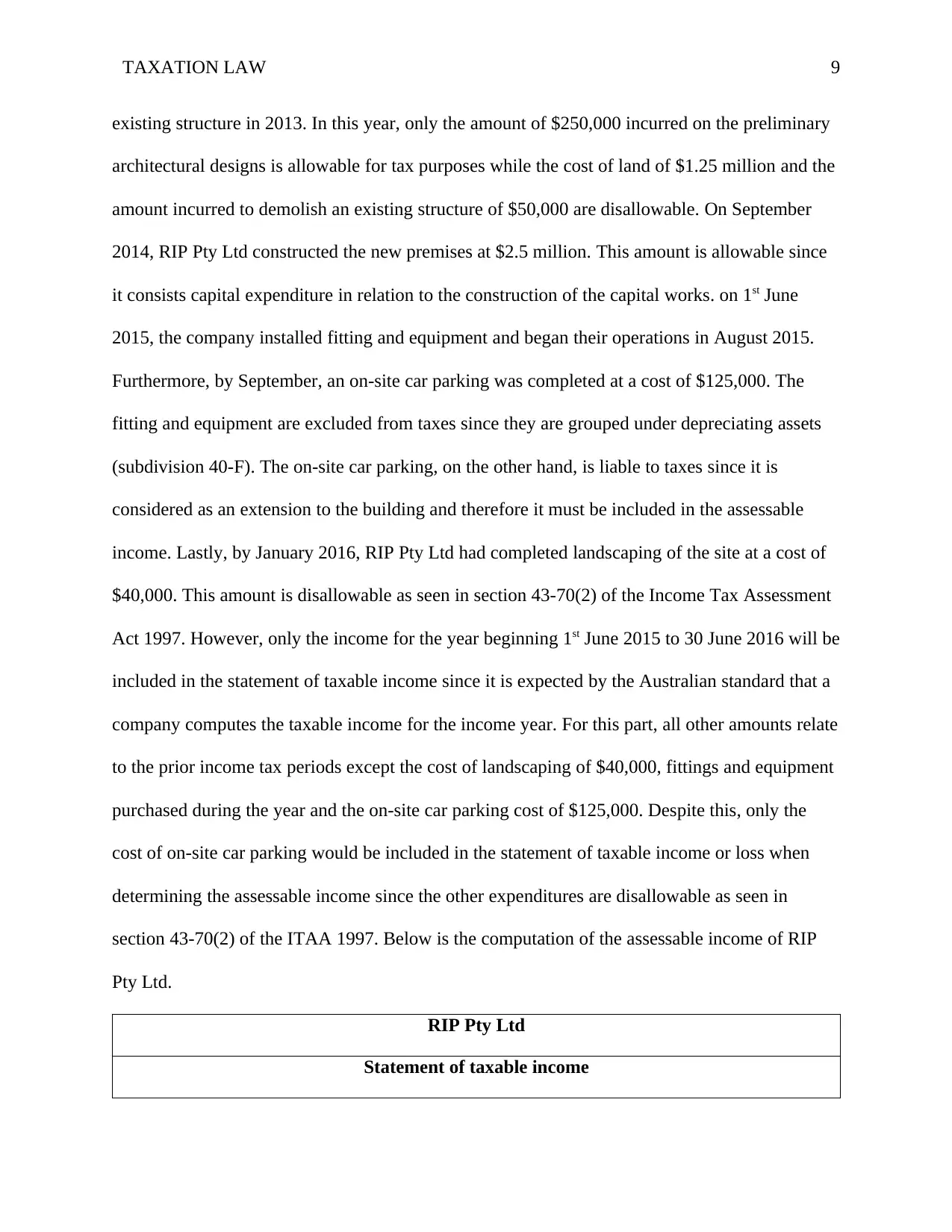
TAXATION LAW 9
existing structure in 2013. In this year, only the amount of $250,000 incurred on the preliminary
architectural designs is allowable for tax purposes while the cost of land of $1.25 million and the
amount incurred to demolish an existing structure of $50,000 are disallowable. On September
2014, RIP Pty Ltd constructed the new premises at $2.5 million. This amount is allowable since
it consists capital expenditure in relation to the construction of the capital works. on 1st June
2015, the company installed fitting and equipment and began their operations in August 2015.
Furthermore, by September, an on-site car parking was completed at a cost of $125,000. The
fitting and equipment are excluded from taxes since they are grouped under depreciating assets
(subdivision 40-F). The on-site car parking, on the other hand, is liable to taxes since it is
considered as an extension to the building and therefore it must be included in the assessable
income. Lastly, by January 2016, RIP Pty Ltd had completed landscaping of the site at a cost of
$40,000. This amount is disallowable as seen in section 43-70(2) of the Income Tax Assessment
Act 1997. However, only the income for the year beginning 1st June 2015 to 30 June 2016 will be
included in the statement of taxable income since it is expected by the Australian standard that a
company computes the taxable income for the income year. For this part, all other amounts relate
to the prior income tax periods except the cost of landscaping of $40,000, fittings and equipment
purchased during the year and the on-site car parking cost of $125,000. Despite this, only the
cost of on-site car parking would be included in the statement of taxable income or loss when
determining the assessable income since the other expenditures are disallowable as seen in
section 43-70(2) of the ITAA 1997. Below is the computation of the assessable income of RIP
Pty Ltd.
RIP Pty Ltd
Statement of taxable income
existing structure in 2013. In this year, only the amount of $250,000 incurred on the preliminary
architectural designs is allowable for tax purposes while the cost of land of $1.25 million and the
amount incurred to demolish an existing structure of $50,000 are disallowable. On September
2014, RIP Pty Ltd constructed the new premises at $2.5 million. This amount is allowable since
it consists capital expenditure in relation to the construction of the capital works. on 1st June
2015, the company installed fitting and equipment and began their operations in August 2015.
Furthermore, by September, an on-site car parking was completed at a cost of $125,000. The
fitting and equipment are excluded from taxes since they are grouped under depreciating assets
(subdivision 40-F). The on-site car parking, on the other hand, is liable to taxes since it is
considered as an extension to the building and therefore it must be included in the assessable
income. Lastly, by January 2016, RIP Pty Ltd had completed landscaping of the site at a cost of
$40,000. This amount is disallowable as seen in section 43-70(2) of the Income Tax Assessment
Act 1997. However, only the income for the year beginning 1st June 2015 to 30 June 2016 will be
included in the statement of taxable income since it is expected by the Australian standard that a
company computes the taxable income for the income year. For this part, all other amounts relate
to the prior income tax periods except the cost of landscaping of $40,000, fittings and equipment
purchased during the year and the on-site car parking cost of $125,000. Despite this, only the
cost of on-site car parking would be included in the statement of taxable income or loss when
determining the assessable income since the other expenditures are disallowable as seen in
section 43-70(2) of the ITAA 1997. Below is the computation of the assessable income of RIP
Pty Ltd.
RIP Pty Ltd
Statement of taxable income
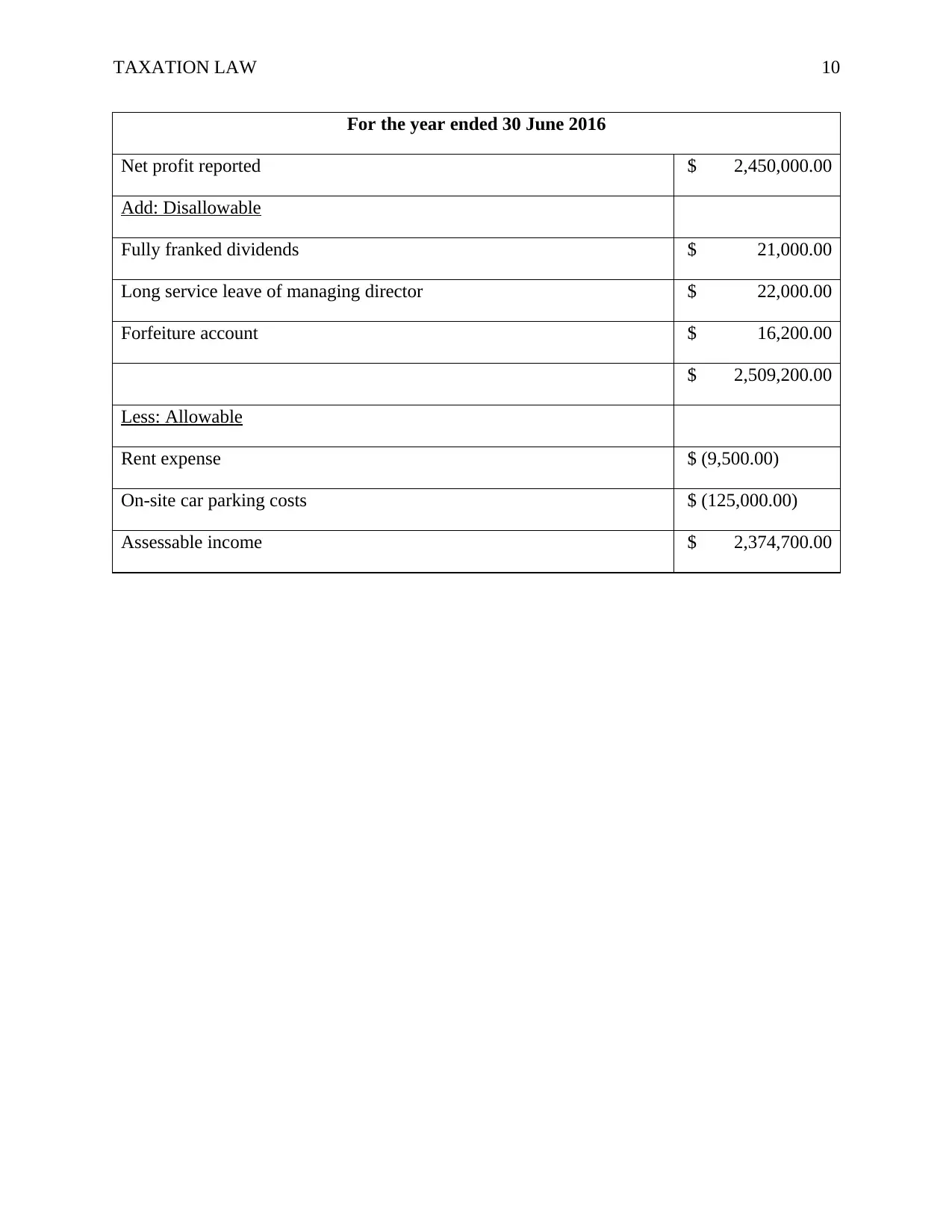
TAXATION LAW 10
For the year ended 30 June 2016
Net profit reported $ 2,450,000.00
Add: Disallowable
Fully franked dividends $ 21,000.00
Long service leave of managing director $ 22,000.00
Forfeiture account $ 16,200.00
$ 2,509,200.00
Less: Allowable
Rent expense $ (9,500.00)
On-site car parking costs $ (125,000.00)
Assessable income $ 2,374,700.00
For the year ended 30 June 2016
Net profit reported $ 2,450,000.00
Add: Disallowable
Fully franked dividends $ 21,000.00
Long service leave of managing director $ 22,000.00
Forfeiture account $ 16,200.00
$ 2,509,200.00
Less: Allowable
Rent expense $ (9,500.00)
On-site car parking costs $ (125,000.00)
Assessable income $ 2,374,700.00
Secure Best Marks with AI Grader
Need help grading? Try our AI Grader for instant feedback on your assignments.
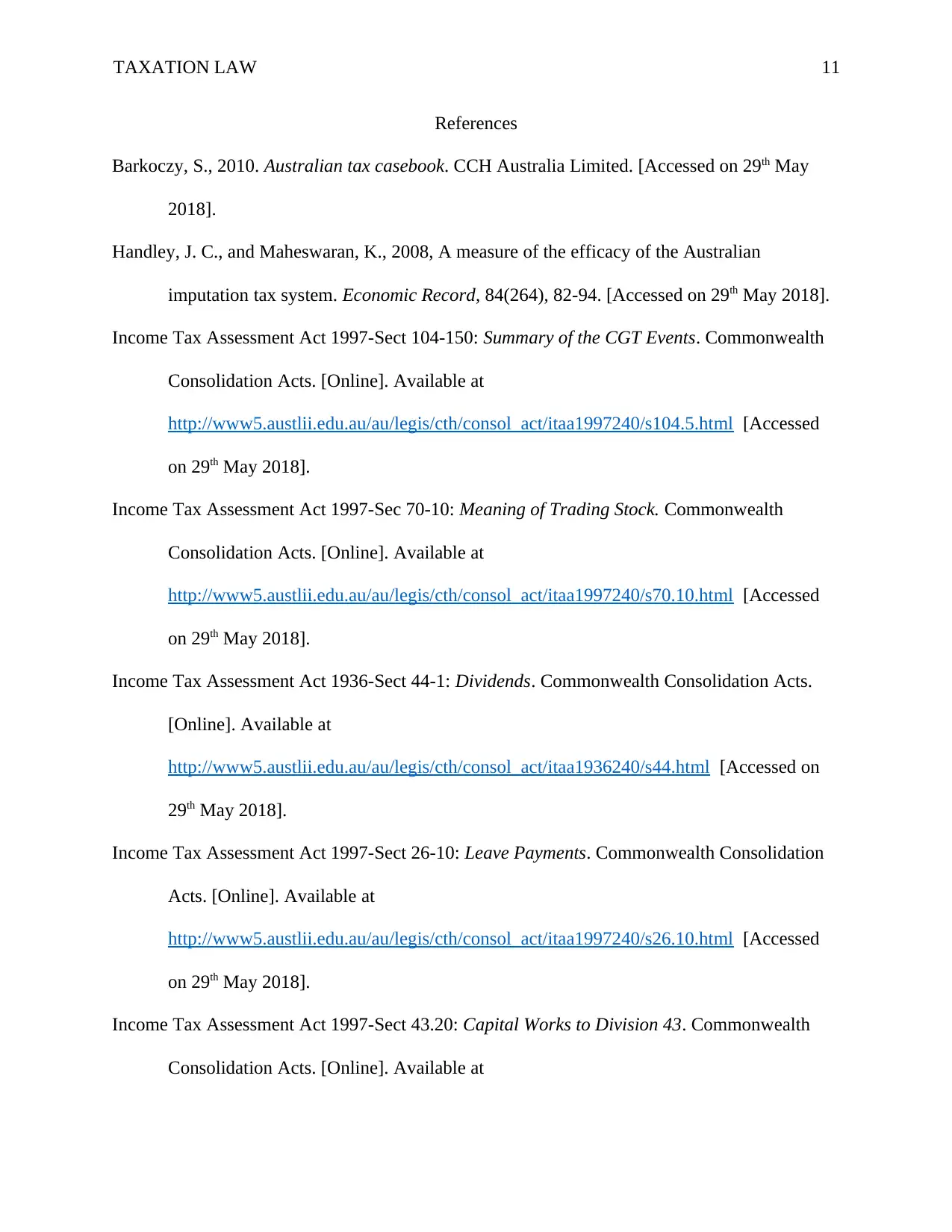
TAXATION LAW 11
References
Barkoczy, S., 2010. Australian tax casebook. CCH Australia Limited. [Accessed on 29th May
2018].
Handley, J. C., and Maheswaran, K., 2008, A measure of the efficacy of the Australian
imputation tax system. Economic Record, 84(264), 82-94. [Accessed on 29th May 2018].
Income Tax Assessment Act 1997-Sect 104-150: Summary of the CGT Events. Commonwealth
Consolidation Acts. [Online]. Available at
http://www5.austlii.edu.au/au/legis/cth/consol_act/itaa1997240/s104.5.html [Accessed
on 29th May 2018].
Income Tax Assessment Act 1997-Sec 70-10: Meaning of Trading Stock. Commonwealth
Consolidation Acts. [Online]. Available at
http://www5.austlii.edu.au/au/legis/cth/consol_act/itaa1997240/s70.10.html [Accessed
on 29th May 2018].
Income Tax Assessment Act 1936-Sect 44-1: Dividends. Commonwealth Consolidation Acts.
[Online]. Available at
http://www5.austlii.edu.au/au/legis/cth/consol_act/itaa1936240/s44.html [Accessed on
29th May 2018].
Income Tax Assessment Act 1997-Sect 26-10: Leave Payments. Commonwealth Consolidation
Acts. [Online]. Available at
http://www5.austlii.edu.au/au/legis/cth/consol_act/itaa1997240/s26.10.html [Accessed
on 29th May 2018].
Income Tax Assessment Act 1997-Sect 43.20: Capital Works to Division 43. Commonwealth
Consolidation Acts. [Online]. Available at
References
Barkoczy, S., 2010. Australian tax casebook. CCH Australia Limited. [Accessed on 29th May
2018].
Handley, J. C., and Maheswaran, K., 2008, A measure of the efficacy of the Australian
imputation tax system. Economic Record, 84(264), 82-94. [Accessed on 29th May 2018].
Income Tax Assessment Act 1997-Sect 104-150: Summary of the CGT Events. Commonwealth
Consolidation Acts. [Online]. Available at
http://www5.austlii.edu.au/au/legis/cth/consol_act/itaa1997240/s104.5.html [Accessed
on 29th May 2018].
Income Tax Assessment Act 1997-Sec 70-10: Meaning of Trading Stock. Commonwealth
Consolidation Acts. [Online]. Available at
http://www5.austlii.edu.au/au/legis/cth/consol_act/itaa1997240/s70.10.html [Accessed
on 29th May 2018].
Income Tax Assessment Act 1936-Sect 44-1: Dividends. Commonwealth Consolidation Acts.
[Online]. Available at
http://www5.austlii.edu.au/au/legis/cth/consol_act/itaa1936240/s44.html [Accessed on
29th May 2018].
Income Tax Assessment Act 1997-Sect 26-10: Leave Payments. Commonwealth Consolidation
Acts. [Online]. Available at
http://www5.austlii.edu.au/au/legis/cth/consol_act/itaa1997240/s26.10.html [Accessed
on 29th May 2018].
Income Tax Assessment Act 1997-Sect 43.20: Capital Works to Division 43. Commonwealth
Consolidation Acts. [Online]. Available at
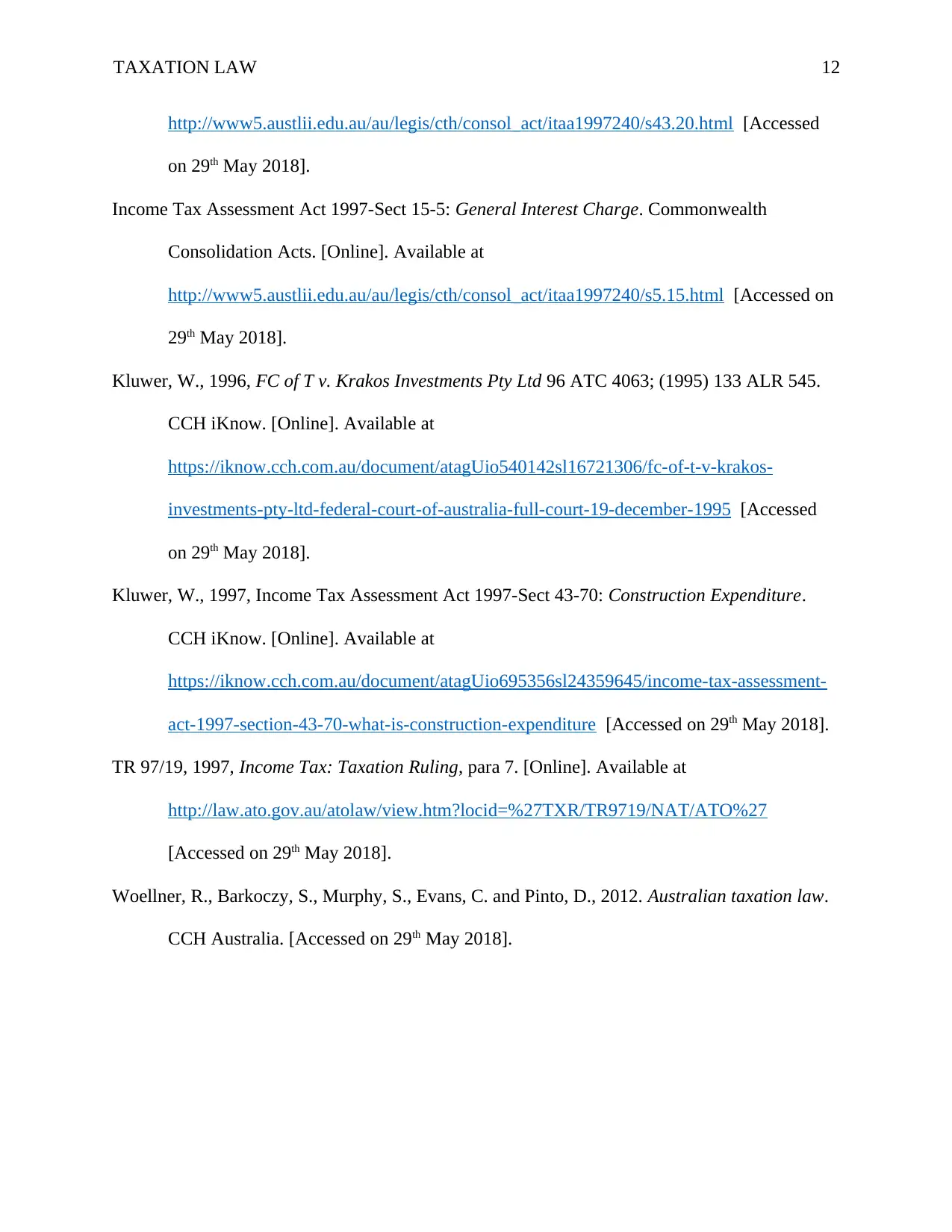
TAXATION LAW 12
http://www5.austlii.edu.au/au/legis/cth/consol_act/itaa1997240/s43.20.html [Accessed
on 29th May 2018].
Income Tax Assessment Act 1997-Sect 15-5: General Interest Charge. Commonwealth
Consolidation Acts. [Online]. Available at
http://www5.austlii.edu.au/au/legis/cth/consol_act/itaa1997240/s5.15.html [Accessed on
29th May 2018].
Kluwer, W., 1996, FC of T v. Krakos Investments Pty Ltd 96 ATC 4063; (1995) 133 ALR 545.
CCH iKnow. [Online]. Available at
https://iknow.cch.com.au/document/atagUio540142sl16721306/fc-of-t-v-krakos-
investments-pty-ltd-federal-court-of-australia-full-court-19-december-1995 [Accessed
on 29th May 2018].
Kluwer, W., 1997, Income Tax Assessment Act 1997-Sect 43-70: Construction Expenditure.
CCH iKnow. [Online]. Available at
https://iknow.cch.com.au/document/atagUio695356sl24359645/income-tax-assessment-
act-1997-section-43-70-what-is-construction-expenditure [Accessed on 29th May 2018].
TR 97/19, 1997, Income Tax: Taxation Ruling, para 7. [Online]. Available at
http://law.ato.gov.au/atolaw/view.htm?locid=%27TXR/TR9719/NAT/ATO%27
[Accessed on 29th May 2018].
Woellner, R., Barkoczy, S., Murphy, S., Evans, C. and Pinto, D., 2012. Australian taxation law.
CCH Australia. [Accessed on 29th May 2018].
http://www5.austlii.edu.au/au/legis/cth/consol_act/itaa1997240/s43.20.html [Accessed
on 29th May 2018].
Income Tax Assessment Act 1997-Sect 15-5: General Interest Charge. Commonwealth
Consolidation Acts. [Online]. Available at
http://www5.austlii.edu.au/au/legis/cth/consol_act/itaa1997240/s5.15.html [Accessed on
29th May 2018].
Kluwer, W., 1996, FC of T v. Krakos Investments Pty Ltd 96 ATC 4063; (1995) 133 ALR 545.
CCH iKnow. [Online]. Available at
https://iknow.cch.com.au/document/atagUio540142sl16721306/fc-of-t-v-krakos-
investments-pty-ltd-federal-court-of-australia-full-court-19-december-1995 [Accessed
on 29th May 2018].
Kluwer, W., 1997, Income Tax Assessment Act 1997-Sect 43-70: Construction Expenditure.
CCH iKnow. [Online]. Available at
https://iknow.cch.com.au/document/atagUio695356sl24359645/income-tax-assessment-
act-1997-section-43-70-what-is-construction-expenditure [Accessed on 29th May 2018].
TR 97/19, 1997, Income Tax: Taxation Ruling, para 7. [Online]. Available at
http://law.ato.gov.au/atolaw/view.htm?locid=%27TXR/TR9719/NAT/ATO%27
[Accessed on 29th May 2018].
Woellner, R., Barkoczy, S., Murphy, S., Evans, C. and Pinto, D., 2012. Australian taxation law.
CCH Australia. [Accessed on 29th May 2018].
1 out of 12
Related Documents
Your All-in-One AI-Powered Toolkit for Academic Success.
+13062052269
info@desklib.com
Available 24*7 on WhatsApp / Email
![[object Object]](/_next/static/media/star-bottom.7253800d.svg)
Unlock your academic potential
© 2024 | Zucol Services PVT LTD | All rights reserved.





